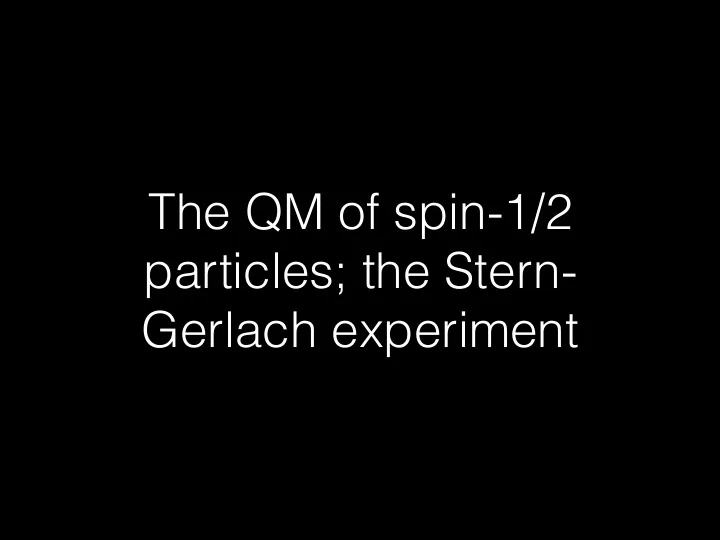

The QM of spin-1/2 particles; the Stern- Gerlach experiment
Preview: the statistical algorithm vs the orthodox interpretation (vs the other interpretations)
Spin in classical mechanics: chalk and talk
Experiment A: the “basic” Stern-Gerlach experiment
Experiment A: the “basic” Stern-Gerlach experiment (0 degrees) (source) (detection screen)
Experiment A: the “basic” Stern-Gerlach experiment (0 degrees) (source) (detection screen)
Experiment A: the “basic” Stern-Gerlach experiment • Observational fact #1: In experiment A, some of the particles are detected in the upper region, and some in the lower region; none are detected in between. (0 degrees) (source) (detection screen)
Experiment A: the “basic” Stern-Gerlach experiment
Experiment B: two consecutive S-Gs (0 degrees) (0 degrees)
Experiment B: two consecutive S-Gs (0 degrees) (0 degrees) (0 degrees) (0 degrees)
Experiment B: two consecutive S-Gs Observational fact #2: In experiment B, all of the particles are detected in the upper region. (0 degrees) (0 degrees)
A conservative Hypothesis: Spin is “quantized”: spin 1/2 particles can be thought of as little compass needles, but only two orientations out of the infinitely many are possible: North up, or North down.
Experiment C: two S-Gs, different angles (0 degrees) (90 degrees) (0 degrees) (0 degrees)
Experiment C: two S-Gs, different angles (0 degrees) (90 degrees) (90 degrees) (0 degrees) (0 degrees) (0 degrees)
Experiment C: two S-Gs, different angles • Observational fact #3: In Experiment C, 1/2 of the particles (that make it through) are detected in the upper region, and 1/2 in the lower region. (And, only half make it through.) (90 degrees) (0 degrees)
Conservative hypothesis If we think of spin 1/2 particles as compass needles, Experiment C shows that they are not forced to point either North up or North down.
The cos^2 law for spin measurements: • If a large number of spin-1/2 particles that have been deflected up after passing through magnets oriented at angle T (measured clockwise from the vertical) are passed through magnets oriented at angle U, then the proportion of the particles that are deflected up is cos^2 [(T-U)/2]
Interlude: the wild and crazy world of quantum mechanics
Experiment D: 3 S-Gs (0 degrees) (90 degrees) (0 degrees)
Experiment D: 3 S-Gs (0 degrees) (0 degrees) (90 degrees) (90 degrees) (0 degrees) (0 degrees)
Experiment D: 3 S-Gs • Observational fact #4: In Experiment D, 1/2 of the particles (that make it through) are detected in the upper region, and 1/2 in the lower region. And, only 1/4 make it through. (0 degrees) (90 degrees) (0 degrees)
A less conservative hypotheses? When a spin 1/2 particle encounters a magnetic field, it almost instantly turns to align, or anti- align, itself with the field.
A start on the QM statistical algorithm • (chalkboard!)
A start on the QM statistical algorithm • Born’s rule: If the “state vector” of a spin-1/2 particle is v, and it is about to pass through SG magnets oriented at angle A, then the probability that it will be deflected up is equal to <v|A up>^2. • The probability that it will be deflected down is <v|A down>^2.
A start on the QM statistical algorithm • Vectors play TWO DIFFERENT ROLES in this algorithm: • Role 1: encode information about what the “system” (particle) will do, when we measure its spin in various directions. • Role 2: represent possible outcomes of spin measurements.
Recommend
More recommend